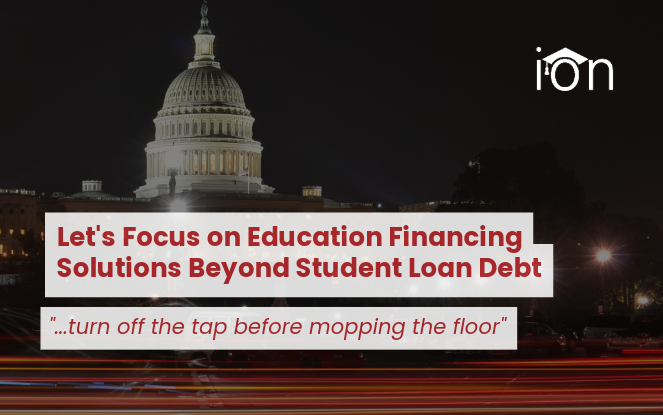by Balaji Rajan
Let’s face it. The focus on student loan debt is an election play and not a “good for the public” policy. This has been the case since 2008. Of course, student loan debt issues must be resolved. But as Education Analyst Carlo Salerno said, “You must turn off the tap before mopping the floor.” I published a version of these suggestions in early 2023 and a couple of them are being proposed.
This is an edited version with one addition of bringing the private sector lenders back into the mix. Maybe a think-tank or two will consider evaluating data and costs.
Here are suggestions to policymakers for real education financing solutions:
1. The loan should only pay for tuition costs
A 4-year degree in Chemistry, Computer Science, or Physics may cost more than any Liberal Arts degree. An index such as the Cost-of-Living Adjustment (COLA) can be used to make tuition adjustments. If an institution believes it should charge more, it should find the education financing solutions itself for the excess amount not covered by taxpayer/Federal dollars. This should apply to all college types – from public to for-profit institutions.
2. Tie tuition costs to forecasted income after graduation
It is ridiculous to ask a teacher candidate to spend $60,000 in tuition costs when their starting salary is $40,000 and their annual loan payments are $6,000. These limits can be set as a ratio to the salaries earned in the first five years of employment; and defer payments for two (2) years after graduation. Of course, PSLF and other programs are useful but should not require payments if the PSLF candidate is in an eligible program.
3. Use existing welfare programs to cover non-tuition expenses
Means testing is done using the FAFSA. Let us incorporate this into welfare programs, and even use the EBT card rails to advance the funds, control abuse, and restrict spending on certain products.
4. Tie rewards to students who graduate on time
These students should be given significant discounts on interest rates. It is an incentive to complete the program of study on time and increase the likelihood of higher incomes.
5. Provide bigger incentives to employers and get them engaged
Lawmakers should provide incentives directly to employers to work with colleges to create custom programs based on their talent pipelines. Incentives should be based on the students hired from these programs.
6. Colleges should consolidate
There are too many colleges and universities. It is like having ten gas stations in a town of 800 people. In Chicago alone, there are 86 colleges with nearly 200 campus locations. This could account for at least 86 Presidents, 150 Administrators, 1,000 Deans, 2,000 professors, janitors, and hundreds more of everything. Seriously!
Lastly, model pilot programs based on other Federal credit programs such as SBAs Small Business Investment Companies (SBIC)
Here, the SBA provides guaranteed loans that an equity investor can use to fund investments in small businesses. When loan proceeds are realized via a sale or repayment the SBA funds are repaid.
A similar “first loss guarantee” of around 10-20 percent by the Education Department to private student loan lenders, with similar current rails could work just as well. The guarantee is less than the FFEL program; private capital comes in because interest rate fluctuations and defaults are covered.
The lifetime defaults are between 28 and 35 percent, of which 60 percent is recovered. Taxpayer dollars are protected, and lenders can be paid a fixed fee to lend and service loans based on true costs. The Department can use competitive procurements for SBIC participation.

